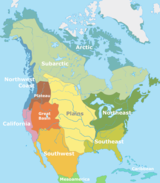
Indigenous peoples of the Subarctic are the aboriginal peoples who live in the Subarctic regions of the Americas, Asia and Europe, located south of the true Arctic at about 50°N to 70°N latitude. This region includes the interior of Alaska, the Western Subarctic or western Canadian Shield and Mackenzie River drainage area, the Eastern Subarctic or Eastern Canadian Shield, and most of Fennoscandia, Northwestern Russia and Siberia.[1] Peoples of subarctic Siberia and Greenland are included in the subarctic; however, Greenlandic Inuit are usually classified as Indigenous peoples of the Arctic.
YouTube Encyclopedic
-
1/5Views:3 59810 1852 587132 950493
-
The Subarctic Peoples of Canada
-
CKLA Unit 8 Lesson 11 Read Aloud: Native Americans of the Arctic/Subarctic
-
Native Americans of the Subarctic Region | The Innu tribe
-
Arctic Native Americans - #socialstudies Educational Video for Elementary Students #inuit #igloo
-
Arctic and subarctic societies : indigenous adaptation and knowledge
Transcription
Languages
Native subarctic peoples have over 38 languages into five major language families: Algonquian,[2] Athapaskan,[2] Indo-European, Turkic and Uralic.
Arts and cultures
The reindeer Tangifer tarandus (caribou in North America) and deer have traditionally played a central role in North American and Asian Subarctic culture, providing food, clothing, shelter, and tools. In North America, items such as the babiche bag are made of caribou and deer rawhide. Moosehair embroidery and porcupine quill embroidery are also worked onto hides and birchbark. After introduction by Europeans and Asians, glass beads became popular and are sewn into floral designs.[1] Additionally, some cultures practiced agriculture, alongside hunting and gathering.[citation needed]
In the Sami culture of Scandinavia, reindeer husbandry has traditionally played an important role. Traditionally the Sami lived and worked in reindeer herding groups called siiddat, which consisted of several families and their herds. Members of the siidda helped each other with the management and husbandry of the herds.[3]
In Russia, many different indigenous peoples engage in reindeer herding, from European Russia right across to Siberia. One of the largest groups are the Nenets people, who practice nomadic herding, migrating long distances each year (up to 1,000 km annually) between their summer and winter pastures.[4] At present about 13,500 Nenets are engaged with reindeer herding.
List of peoples
- Na-Dene
- Athabaskan–Eyak
- Athabaskan
- Northern Athabaskan
- Athabaskan
- Tlingit, United States (Alaska) and Canada (British Columbia and Yukon)
- Athabaskan–Eyak
- Algic
- Turkic
- Kipchak
- Kipchak–Bulgar
- Bashkir, Russia (Bashkortostan)
- Tatars
- Volga Tatars, Russia (Tatarstan)
- Kipchak–Bulgar
- Oghur
- Siberian Turkic
- Northern Turkic
- Dolgans
- Yakuts, Russia (Sakha Republic)
- Northern Turkic
- Kipchak
- Uralic
- Baltic Finnic
- Izhorians, Russia
- Karelian, Finland (South Karelia and North Karelia) and Russia (Republic of Karelia and Leningrad Oblast)
- Veps, Russia
- Votes, Russia
- Permian
- Komi, Russia (Komi Republic and Perm Krai)
- Udmurt, Russia (Udmurtia)
- Sámi
- Ugrians
- Khanty, Russia (Khanty-Mansi Autonomous Okrug)
- Mansi, Russia (Khanty-Mansi Autonomous Okrug)
- Volga Finnic
- Baltic Finnic
- Indo-European
- Germanic
- North Germanic
- Faroe Islanders, Faroe Islands
- North Germanic
- Slavic
- East Slavic
- Russians, Russia
- East Slavic
- Germanic
- Inuit
- Nunatsiavut, Canada (Labrador)
- NunatuKavut, Canada (Labrador)
See also

Notes
- ^ a b c d e f g h History of Indigenous Art in Canada Archived 2011-05-23 at the Wayback Machine The Canadian Encyclopedia. (retrieved 29 Dec 2010)
- ^ a b Corbett, Steve. "Native Peoples of the Subarctic." Archived 2011-05-29 at the Wayback Machine Johnson County Community College. (retrieved 21 Nov 2010)
- ^ "Sámi - Norway". Reindeerherding.org. Retrieved 12 March 2019.
- ^ "Nenets". Reindeerherding.org. Retrieved 12 March 2019.

